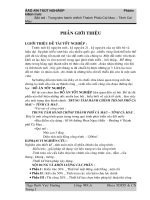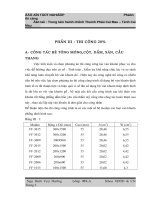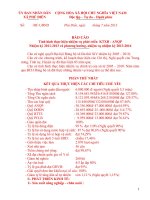Pgramatic chapter8 pot
Bạn đang xem bản rút gọn của tài liệu. Xem và tải ngay bản đầy đủ của tài liệu tại đây (602.13 KB, 37 trang )
Members of our Group:
Nguyen Hong Nhu
Tran Thi Minh Xuan
Nguyen Thi Mai Lan
Vuong Thi Tuyet
Chapter 8:
Presented by: Nguyen Hong Nhu
To make the conversation run smoothly, there are
some aspects to be considered i.e.
• Conversation analysis
• Pauses, overlaps and back channels
• Conversational style
• Adjacency pairs
• Preference structure
•
Floor
•
Turn
•
Turn-taking
•
Local management system
•
Transition Relevance Place
Floor: the right to speak
Turn:
having control of the right to speak. It is seen
as everything one speaker says before another
begins to speak
Ex:
Speaker 1: Can you help me? (turn 1)
Speaker 2: Sure. (turn 2)
A$
turn
$is the essential factor within turn taking,
which is attached to a speaker. Each speaker
takes$
turns$
within conversation
Turn-taking: attempt to take control of the right to speak.
-
a cyclical process
- two central aspects:
+ Frequency: the amount of turn taking within a conversation
+ Control of contribution: the amount of control a person has over
what to say and how much to say.
Speakers having the conversation are supposed to change
turn smoothly because they are aware of the local
management system for taking those turns at an
appropriate TRP.
Local management system:
A set of conventions for getting turns, keeping them,
or giving them away.
TRP – A Transition Relevance Place
Any possible change – of – turn point.
-
speakers having a conversation =
taking turns at holding the floor
-
speakers may cooperate and share the floor
equally
- speakers may compete for keeping the floor,
preventing others from getting it
Cauon:
II. Pauses, overlaps, and
backchannels
Pauses:
a break in speaking; a moment of silence
- playing an important role in conversation
- giving the impression that you are carefully weighing
your words before you speak
• Types of pauses:
The functions of Pauses:
!"
!#
!
!$%
!#%
overlap
• If two speakers try to make utterances at the same
time, this is called an overlap,
• Transitions with overlap are perceived as
awkward
SITUATION: Student with girlfriend’s father during their first meeting.
Mr. Strait: What’s your major, Dave?
Dave: English - well I haven’t really decided yet.
(3 seconds)
Mr. Strait: So - you want to be a teacher?
Dave: No - not really - well not if I can help it
(2 seconds)
Mr. Strait: Wha - // Where do you - // go ahead
Dave: I mean it’s a - oh sorry // I em -
&#
'
“-”: short pauses, hesitaons
“//”: beginning of overlap (both speakers aempt to iniate talk)
(#)*
#&#
+
(',-'(./0
1Dave, I’m going to the store
2%
1Dave?
2%
1Dave - is something wrong?
0What? What’s wrong?
1Never mind
.
!###
33
(',-'(./
4Did you see him in the video?
5Yeah - the part on the beach.
4Oh, my god // he was so sexy.
5 // he was just being so cool
4And all the waves // crashing around him!
5 // yeah that was really wild!
!.
(',-'(./
1!-/((/(67
1*(!
#)
Another oor holding device is to indicate that there is a
larger structure to your turn
a. There are three points I'd like to make )rst
b. There's more than one way to do this one example
would be
c. Didn't you know about Melvin? - Oh, it was last October
d. Did you hear about Cindy's new car? - She got it in
a & b: technical informa0on about coming structure
c & d: preludes to storytelling
BACKCHANN
BACKCHANN
EL
EL
What are backchannels?
What are backchannels?
Definition:
Backchannels are listener responses given
while someone else is talking to show interest,
attention or a willingness to keep listening.
Backchannels are typically short utterances
such as uh-huh, mmm, yeah…
Here is an example, with audio:
Here is an example, with audio:
•
A: Is it like a party, like, “rave” type party? or like
•
C: well, it’s someone’s house
•
A: yeah
•
C: there’s going to be, I mean there’s like, they’re
going to be spinning. So, in that sense, maybe,
but it’s just at someone’s house, like
•
A: yah-yeah
•
C: it’s in the middle of the night, that too, but
Another example:
Another example:
Caller: if you use your long distance service a lot then you’ll
Caller: if you use your long distance service a lot then you’ll
Mary:
Mary:
uh-uh
uh-uh
Caller: be interested in the discount I'm talking about
Caller: be interested in the discount I'm talking about
because
because
Mary:
Mary:
yeah
yeah
Caller: it can only save you money to switch to a cheaper
Caller: it can only save you money to switch to a cheaper
service
service
Mary:
Mary:
mmm
mmm
Purposes:
Purposes:
These types of signals (yeah, ya-yeah, uh-uh, mmm)
These types of signals (yeah, ya-yeah, uh-uh, mmm)
provide feedback to the current speaker that the message is
provide feedback to the current speaker that the message is
being received.
being received.
They normally indicate that the listener
They normally indicate that the listener
is following, and not objecting to what the speaker is saying.
is following, and not objecting to what the speaker is saying.
During telephone conversation: the absence
During telephone conversation: the absence
of backchannels may promt the
of backchannels may promt the
speaker to ask if the listener is still there.
speaker to ask if the listener is still there.
During face to face interaction: the absence
During face to face interaction: the absence
of backchannels may lead to a misuderstanding.
of backchannels may lead to a misuderstanding.
Conversational style
Conversational style
There are two styles of conversation: high involvement style
There are two styles of conversation: high involvement style
and high considerateness style.
and high considerateness style.
High involvement style:
High involvement style:
someone’s participation in a
someone’s participation in a
conversation will be very active, speaking rate will be
conversation will be very active, speaking rate will be
relatively fast, with almost no pausing between turns, and
relatively fast, with almost no pausing between turns, and
with some overlap or even completion of the other’s turn.
with some overlap or even completion of the other’s turn.
High considerateness style:
High considerateness style: speakers use a slower
rate, expect longer pauses between turns, do not overlap,
and avoid interruption or completion of other’s turn.
When a speaker of the first style gets into a conversation
with a speaker of the second style, the talk tends to become
one-sided and misunderstanding may occur.
4. Adjacency Pairs
• An adjacency pair is composed of two utterances
by two speakers, one after the other. The
speaking of the first utterance (the first-pair part,
or the first turn) provokes a responding utterance
(the second-pair part, or the second turn).
4. Adjacency Pairs
For example:
the first-pair part:What’s your name?
The second- pair part: My name’s Lan.









![Tài liệu bang phan cong giam sat xa Phu Dien[1] pot](https://media.store123doc.com/images/document/14/br/se/medium_seo1393442416.jpg)